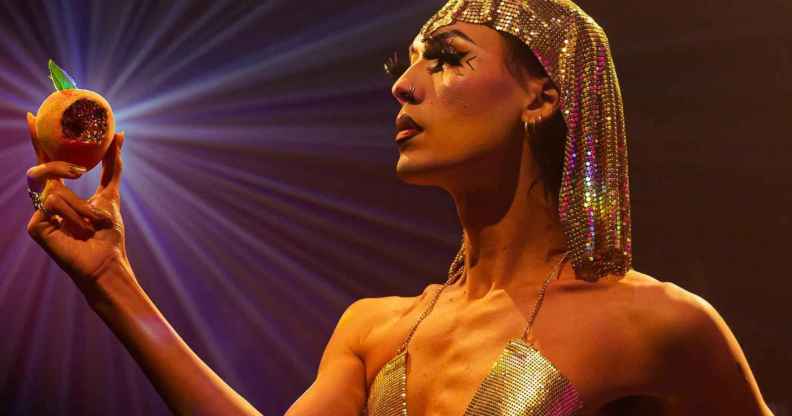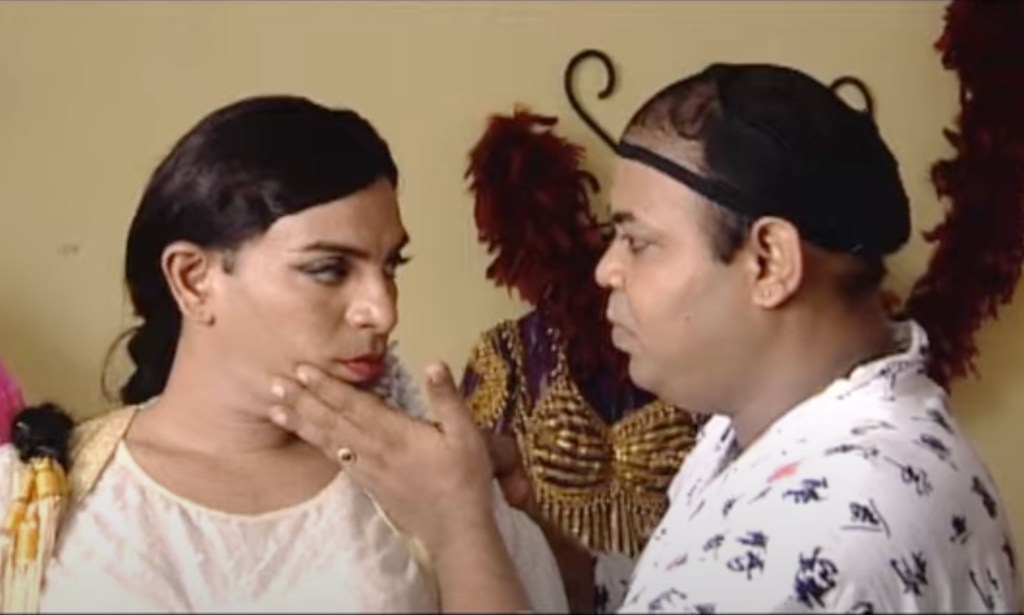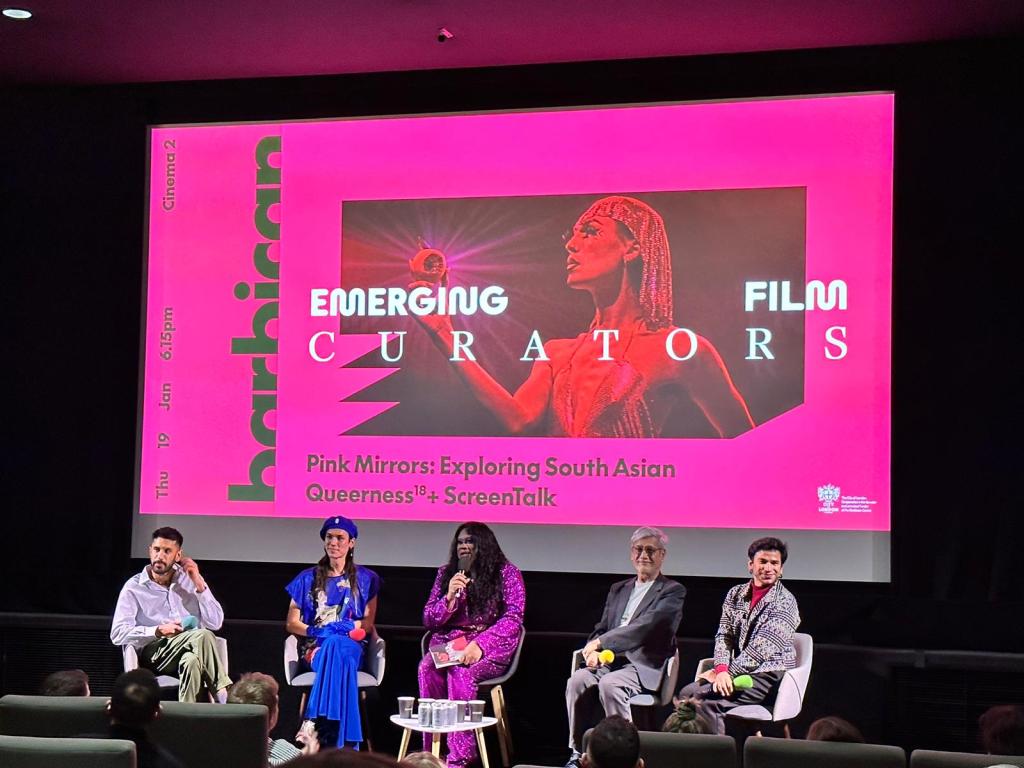This vibrant new film series celebrates the forgotten history of queer South Asian cinema

A still from queer South Asian film Peach Paradise (Shiva Raichandani)
Barbican emerging film curator Harry Singh tells PinkNews about the journey to creating Pink Mirrors, a celebratory series of short films exploring queer South Asian communities.
Earlier in January, Pink Mirrors showcased a vibrant selection of short films – BOMgAY, Gulabi Aaina, The Booth and Peach Paradise – exploring journeys of self-discovery, desire and protest in queer South Asian communities over several decades.
Over the course of two hours, the audience was guided through the underground gay community of 1990s Mumbai and experienced an electrifying moment tension between two women at an Indian shopping centre.
The films are not only linked by their fearless approach to platforming LGBTQ+ voices, but also by the dint of the fact that they are made by and for the communities they portray.
While viewers have been enjoying subversive queer South Asian cinema on the big screen, the showcase, which is part of the Barbican’s cinema programme from up-and-coming film curators, actually started life as a curious lockdown hobby for Harry Singh.

It was after watching countless LGBTQ+ films during the pandemic that Singh, a queer South Asian man, suddenly thought: “Hold on, where are we in all of this?”
Reflecting on the origins of the acclaimed exhibition, the curator tells PinkNews that he got “fatigued” searching for representation, which inspired him to seek out stories that reflected his experience.
“I went on a bit of a hunt to find these films, and they do exist. And, well, here we are.”
Perhaps the most difficult to procure, Singh explains, was BOMgAY. Based on poetry by R. Raj Rao and starring Rahul Bose, the short film from Indian filmmaker Riyad Vinci Wadia features an anthology of six short clips that give a candid insight into the thriving gay community in the 1990s.

It tells of a community connected via tunnels in the public subway and surreptitious meetings in parks – a story Singh describes as one of “desire, lust and chosen family”.
“It challenged my notions of what queer life in India was,” he says. “Admittedly, I, too, had perhaps a bit of a Western gaze. BOMgAY made me realise while a lot of it was underground, it was also quite open.
“You start to learn about how public spaces were a big part of the gay community in India in the 90s. Just the idea of the love and connection that they had with each other.”
Though Rao and Wadia were trailblazers in the 90s gay Indian arts scene, they were held back from distributing BOMgAY commercially due to fears they would never get it past the film censor.
Their fears weren’t unfounded, for it famously features India’s first ever gay sex scene. “When you take your mind back to 90s India, it’s kind of extraordinary that that film was ever made,” says Singh.
Extraordinary but not impossible, as gay rights activist and photographer Sunil Gupta explained during a panel talk at the Barbican.
Gupta grew up in India in the 1950s and 1960s, and after lengthy stints in the USA and UK, returned to India in the early 2000s.
His striking photography, capturing the daily reality of gay Indians, stirred huge controversy when displayed in 1980s England. Gupta was undeterred by the outrage, and, to this day, continues to showcase startling portraits of gender, sexuality and love in all its vibrant beauty.
“There was never a time when there wasn’t same-sex sex happening,” Gupta told the audience about his youth.
The film notably reflects on Section 377, a penal code introduced via British colonial rule that criminalised homosexuality alongside pedophilia, bestiality and sexual assault. In an historic move, the legislation was revised in September 2018 to remove mentions of homosexuality.
“When I started discovering these films it was the most incredible moment for me,” Singh explains. “Because of the complexities of being queer and Asian, [Western media] often does not have an accurate portrayal of us.”

The namesake of the evening, Gulabi Aaina, meaning The Pink Mirror, is also inspired by another revolutionary piece of media.
Created in 2003 to raise awareness of the Aids epidemic in India, the 40-minute film gives a unique subcontinental perspective on drag culture through the tender and often hilarious story of a drag queen and her adopted drag mother.
Quintessentially South Asian, it shows LGBTQ+ chosen family through the familiar lens of Indian soap opera, complete with dramatic music, frenetic editing and witty innuendo.
For Singh, including sapphic representation in the series was vital. 2019 short film The Booth follows a shopping mall security guard who strikes up a flirtatious relationship with another woman.
Each day, they find pockets of time together in the ‘booth’; a small curtained room used to search shoppers.
“It’s really good at depicting how fragile queer love can be in India, particularly for women,” says Singh. “So that was a really touching film.”

Pink Mirrors arrives in the present day with Peach Paradise. Directed by Shiva Raichandani, it explores the awe-inspiring story of the UK’s first pan-Asian drag collective.
For Singh, there’s no doubt that there’s a pressing need to celebrate the rich history of queerness in South Asian communities.
From the 1985 gay classic My Beautiful Laundrette to the three hour erotic saga Fire, he emphasises that “stories by our community and for our community” are out there – they just need to be uncovered.
At the screening, Singh’s hopes that people would be able to step out of the shadows and find community came true.
Whether through the shared laughter at the most audacious moments in Gulabi Aaina or the charged silence as two women found connection in The Booth, for one glorious moment the room moved as one.
You can discover the Barbican’s Emerging Curator Film series here.
How did this story make you feel?

